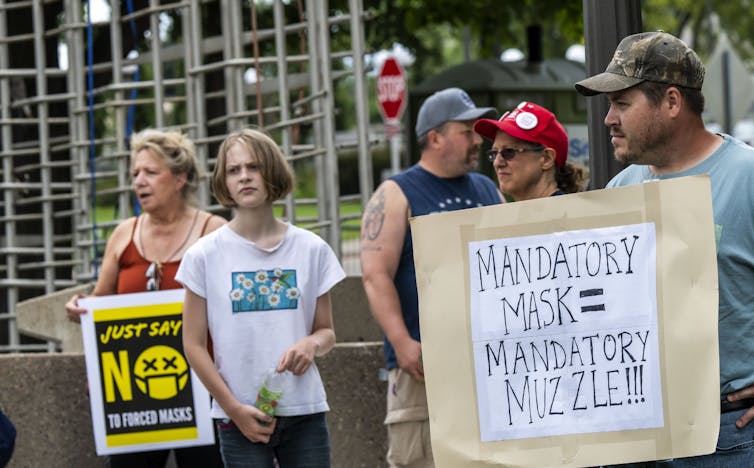Ask Donald Trump

The United States has lagged behind much of the world in its efforts to contain the COVID-19 pandemic. Not wearing a mask has become a political act even though masks slow the spread of the virus. As someone who just finished a dissertation on political bias, I was not surprised.
During the early days of the COVID-19 pandemic, there was a lot of uncertainty about the virus as scientists were still learning about it. This resulted in some mixed messaging from health organizations regarding the importance of wearing masks. Research finds that individuals turn to experts during times of national crisis, but the uncertainty from experts made political leaders a prominent source for guidance and clarity.
The message from American politicians was much more direct, but also differed substantially by political party. Democratic politicians generally took the virus much more seriously and quickly adopted mask-wearing behaviors compared to Republicans. President Trump consistently downplayed the severity of the virus and often refused to wear a mask. This created a clear political divide among politicians about how seriously they took the outbreak.
The social science of political bias
This division within politicians was internalized by the American people as well, according to research and surveys. Identifying as a Democrat was significantly associated with practicing social distancing and being concerned about the virus.
Additionally, Republicans were far less likely than Democrats to view COVID-19 as a major threat to public health, according to a recent survey by the Pew Research Center. Sixty-three percent of Democrats and Democratic-leaning independents said that masks should be worn always, compared to just 29% of Republicans and those leaning Republican.
Furthermore, 23% of Republicans said that masks should rarely or never be worn, compared to just 4% of Democrats. Finally, a recent CBS/YouGov poll showed that 57% of Republicans believed the number of U.S. deaths from coronavirus had been acceptable, compared to 10% of Democrats.
Once the decision to wear a mask became informed by political beliefs, it did not matter that scientists better understood the severity of the virus and the evidence in favor of mask wearing became clearer.
Why? Research on identity theory shows that individuals are motivated to maintain consistency between the values associated with their identity and the information they encounter. The groups we identify with provide us with a sense of belonging and self-worth. Thus, if we identify with a political group, our psychological motivation is to process information in a way that supports the group we belong to.
This identity protection process was exactly what I found in my dissertation as well. Both Democrats and Republicans interpreted fictitious news headlines very differently depending on whether the headline was favorable or unfavorable toward their political group. This is consistent with a meta-analysis showing robust political bias for both Democrats and Republicans.
Political polarization is extremely strong in the United States, which further perpetuates political bias. The political divide regarding COVID-19 has actually grown over time, despite our increased knowledge of the virus and the efficacy of mask wearing.
How does this divide continue despite the greater knowledge we have about the virus? Well, Democrats and Republicans trust and consume different news media. These media bubbles can lead to many Americans receiving news regarding COVID-19 that is biased toward supporting their political in-group.
Democrats and Republicans each prefer to associate with people who share their political beliefs. Research has also found that political attitudes become more extreme after a group discussion with like-minded people. Additionally, a study of mine found that greater political homogeneity in one’s personal network was associated with stronger political beliefs.
This finding was replicated in my dissertation research where I found political polarization was positively associated with having a greater proportion of close associates who hold similar political beliefs.
In summary, once misinformation becomes political, it is very hard to correct because of our motivation to protect our identity and the reinforcement from our political echo chambers.
What next?
To slow the spread of the coronavirus, Republican and Democratic politicians could take COVID-19 equally seriously and listen to the experts. Reducing the political nature of the pandemic will increase people’s receptiveness to information from scientists.
On an individual level, people can also make an effort to reach out to those who are against mask wearing and don’t take the virus seriously. As my research shows, depolarization can occur when there is exposure to opposing viewpoints in one’s personal network.
Furthermore, I found in my dissertation that Republicans were more likely to agree that climate change is influenced by human activity when they had more positive feelings toward Democrats. This is consistent with other work that shows how connecting with people we disagree with on an emotional level is key for depolarization and persuasion.
Relating this to the pandemic, we can say that when members of our community engage in mask wearing, it becomes more solidified as a social norm among our group, which ultimately leads to more people adopting the behavior.
Finally, increasing mask wearing is just one hurdle. There may be a vaccine for COVID-19 in the months ahead, but the majority of people will have to take it for herd immunity to be achieved. Unfortunately, some polls suggest that about 50% of people may not take the vaccine once it becomes available.
Hopefully, the pandemic is less politically charged by then and we can defeat this virus together.![]()
Matthew Facciani, Postdoctoral Researcher, Vanderbilt University
This article is republished from The Conversation under a Creative Commons license. Read the original article.